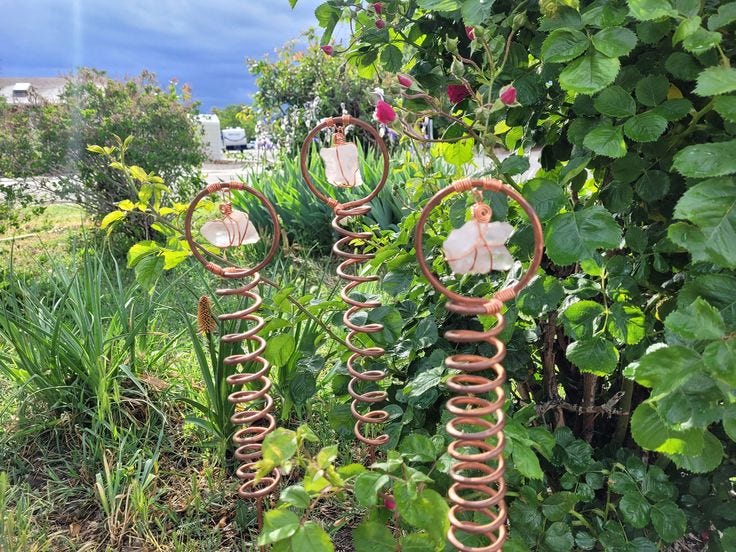In today’s world of depleted soils and chemical-heavy farming, more people are turning to natural methods to revitalize the earth and grow healthy food. One such ancient-yet-revived technique is electroculture gardening—a chemical-free, low-maintenance way to boost plant growth using the Earth's natural energy.
This guide will walk you through what electroculture is, how it works, and how you can build your own electroculture setup at home to help your garden thrive—without fertilizers or pesticides.
What Is Electroculture?
Electroculture is the practice of using atmospheric electricity and magnetism to stimulate plant growth. By installing copper antennas in the soil, gardeners can harness the Earth’s energy field—creating an environment that encourages healthier, faster-growing plants.
This concept isn’t new. Electroculture dates back to the 1800s and was studied in the 1920s and 1930s by researchers like Justin Christofleau, who discovered that certain antenna setups significantly increased crop yields.
How Does It Work?
Electroculture works by:
Drawing atmospheric energy (electrostatic and magnetic fields) into the soil.
Encouraging microbial activity and soil regeneration.
Helping plants draw in more nutrients and water naturally.
Basis of Electroculture
Electroculture gardening is the understanding that plants are sensitive to electrical signals. Like humans and animals, plants have cell membranes that can conduct and respond to electrical currents. Gardeners can influence various physiological processes by providing plants with carefully controlled electrical stimulation, such as nutrient absorption, photosynthesis, and hormone production.
Electricity plays a crucial role in plant growth. When an electrical current applies to a plant, it stimulates the production of auxins, which are plant hormones responsible for cell elongation and growth. Additionally, electricity enhances the movement of nutrients and water within the plant, improving nutrient uptake and overall plant health.
Benefits of Electroculture Gardening
Electroculture gardening offers several advantages over traditional gardening methods. Firstly, it can significantly increase crop yield, allowing gardeners to grow more fruits and vegetables in a limited space. Secondly, electroculture improves plant health and resistance to diseases and pests, reducing the need for chemical pesticides. Lastly, this method is environmentally friendly, minimizing water usage and soil erosion.
Using electroculture techniques, gardeners can stimulate plant growth and accelerate maturation. This means one can harvest crops earlier, providing a continuous supply of fresh produce throughout the growing season. Electroculture also enhances flowering and fruiting, resulting in larger and more abundant fruits and vegetables.
Additionally, electroculture gardening also promotes the overall health and vitality of plants. The electrical stimulation strengthens the plant’s immune system, making it more resistant to diseases and pests. This reduces the need for chemical interventions and promotes sustainable and organic gardening practices. It also enhances the plant’s ability to withstand environmental stresses, such as drought or extreme temperatures.
Step-by-Step Guide to Building Your Own Electroculture Setup
Step 1: Gather Your Materials
You don’t need anything expensive or high-tech to get started. Here's what you'll need:
Copper wire (14–18 gauge is ideal)
Wooden dowels, bamboo sticks, or untreated wooden rods (for antenna support)
Pliers or wire cutters
A compass (to align your setup with magnetic north)
(Optional) Neodymium magnets to enhance the energy effect
How do I make an electroculture antenna?
Atmospheric antennas can be made out of wood dowels found at Home Depot, Lowes, or a local piece of wood from your backyard. The taller you make the antenna the larger your plants will grow. Justin Christofleau recommended 20 feet+, but any height will do.
You can wrap the wood dowel or local wood with copper and zinc wiring making a fibonacci spiral or vortex up in the air facing Magnetic North. The combination of zinc and copper can work like a battery when the sun hits the the antenna. You will then place this antenna about 6-8 inches into your soil and let Mother Nature do the magic. Get creative, try different designs, and you will see the true potential of electroculture.
For more on this topic we offer a free download of Justin Christofleau's Electroculture book
Step 2: Build the Copper Antenna Coil
This antenna is the core of your electroculture device.
Take your wooden or bamboo stick—ideally 3 to 6 feet tall.
Wrap the copper wire around it in a spiral motion, starting from the base and going upward.
Leave a few inches of wire sticking out from the top to act as the “antenna tip.”
If desired, place a magnet on the top to amplify the electrical field.
Make sure the bottom portion of the copper wire touches the soil when installed.
Step 3: Install the Antenna in Your Garden
Insert the wooden rod into the soil 6–12 inches deep.
Ensure the copper coil is firmly in contact with the soil at the base.
Use a compass to face the antenna coil to magnetic north—this orientation aligns the setup with the Earth’s natural magnetic field.
Space multiple antennas around your garden bed every 6–10 feet for maximum coverage.
Step 4: Water and Monitor
After setup:
Water your garden as usual, but you may notice reduced water needs as plants become more resilient.
Monitor plant health and growth over 1–2 weeks. Many people report stronger stems, faster sprouting, and vibrant foliage after only a short time.
Step 5: Experiment and Scale
Not every garden will react the same way, so:
Try different antenna heights and spacing.
Document the impact on various plant types.
Share results with others and refine your setup.
Adjusting Electro Culture Parameters
Adjusting electro-culture parameters is a crucial aspect of successful electro-culture gardening. To ensure optimal growth and development of your plants, follow these steps:
Identify the current parameters: Before making any adjustments, determine the current electroculture parameters of your garden, including voltage, frequency, and duration of electrical impulses.
Research optimal ranges: Study the specific plant or crop you are growing and find the ideal electro-culture parameters for its growth. Different plants may require different ranges of electrical impulses.
Adjust voltage: Based on your research, modify the voltage of the electrical impulses delivered to the plants. Use a voltage regulator or adjust the settings on your electro-culture system.
Modify frequency: Experiment with different frequencies of electrical impulses to find the one that best suits your plants. Increasing or decreasing the frequency can affect plant growth and health differently.
Monitor plant response: Observe how your plants respond to the adjusted electroculture parameters. Look for improved growth, increased yield, or enhanced resistance to pests and diseases. Keep track of any changes or improvements you notice.
Fine-tune the parameters: If necessary, based on your observations and plant response, make further adjustments to the electro culture parameters. Finding the optimal settings for your specific plants may take some trial and error.
Maintain consistency: Once you have determined your plants’ ideal electro culture parameters, strive to maintain consistency in delivering the electrical impulses. Regularly monitor the voltage and frequency to ensure they remain within the desired ranges.
Pro-tip: Keeping a record of your electro-culture adjustments and the corresponding plant responses is recommended. This will help you track the effectiveness of different parameter settings and refine your approach over time.
Types of Plants Suitable for Electroculture
Best Fruits for Electroculture
Tomatoes: Tomatoes respond well to electroculture, producing larger and sweeter fruits with extended shelf life.
Strawberries: Electroculture can enhance the flavor and size of strawberries, making them juicier and more flavorful.
Peppers: Peppers grown using electroculture techniques tend to be more vibrant in color and have a higher concentration of beneficial compounds.
Best Vegetables for Electroculture
Lettuce: Electroculture can accelerate growth, producing crisp and tender leaves.
Cucumbers: Cucumbers grown with electroculture techniques tend to be more uniform in shape and have a higher water content.
Spinach: Electroculture promotes the growth of nutrient-dense spinach leaves, making them an excellent choice for health-conscious gardeners.
Electroculture Gardening FAQs: Everything You Need to Know Before You Start
Can I use a copper pipe instead of making a coiled antenna?
You can use a copper pipe, but results tend to be better with coiled copper wire. The spiral shape is believed to harness and concentrate atmospheric energy more effectively than a straight pipe.
What type of wood should I use for the antenna?
Any untreated wood will work, but the best option is wood from your own backyard, as it may resonate with the natural frequency of your environment. If that’s not possible, bamboo sticks or wood dowels from a hardware store are good alternatives.
Can electroculture be used on indoor or potted plants?
Yes, electroculture works very well indoors. A simple chopstick wrapped with copper wire makes a great small antenna for potted plants or windowsill herbs.
Will the antenna attract EMFs or Wi-Fi signals?
Electroculture antennas are designed to pick up natural Earth energies like static electricity and magnetism. They don’t amplify EMFs or Wi-Fi. That said, limiting EMF exposure at home is still a good idea, especially since long-term effects are still being studied.
Can I wrap my plants in copper instead of making antennas?
It’s not recommended to wrap copper directly around your plants. Some plants may not respond well to being restricted. A nearby antenna is a better and safer way to support plant growth.
How tall should an electroculture antenna be?
You can experiment with height, but 6 feet or taller is ideal for capturing more atmospheric energy. For raised beds or containers, antennas as short as 3 feet can still be effective.
Should I worry about lightning striking the antennas?
Historically, old-world buildings used many lightning rods to balance energy, and there are no modern safety concerns with electroculture antennas. They are passive structures, not conductors of lightning.
How much area does one antenna cover?
A standard 6-foot antenna can energize about 225 square feet of garden space. Larger gardens may benefit from multiple antennas placed evenly throughout.
Which direction should I wind the copper coil?
Northern Hemisphere: Wind the coil clockwise
Southern Hemisphere: Wind it counter-clockwise
Start at the bottom of the stick and spiral upward for the best energy flow.
Does the copper need to touch the soil?
Yes. It’s essential that the lower end of the copper coil is in direct contact with the soil, allowing it to draw in Earth energy.
Where can I find copper wire?
Copper wire is available at hardware stores like Home Depot, Lowe’s, Ace Hardware, Menards, or even local scrap yards. You can also order it online.
Can I use electroculture in raised beds?
Absolutely. Just place one antenna in each raised bed. In smaller beds, an antenna 3–6 feet tall is usually sufficient.
Can I use aluminum instead of copper?
It’s best to avoid aluminum. Aluminum can leach into the soil and may pose health and environmental risks.
Does the copper wire gauge matter?
Any gauge will work, but heavier gauges (12–14) are more durable outdoors. Lighter gauges (16–18) are easier to work with and great for indoor or small setups.
Can I add crystals or gemstones to my antenna?
Yes. Crystals like quartz or amethyst can enhance your setup by providing different energy frequencies and may even attract pollinators with their reflective colors.
Will this affect worms or soil life?
Not at all. Electroculture antennas actually support a healthier soil ecosystem and may help encourage more worm activity.
Can I use coated or scrap copper wire?
Yes, but make sure to strip off the coating at the ends so that bare copper is in contact with the soil and air.
Can electroculture be used with hydroponics?
Yes, but traditional antennas may not work in water. Instead, try using copper pyramids in or around your hydroponic system for similar energetic benefits.
Can it help with seed sprouting?
Yes. Many gardeners report that electroculture boosts germination rates. A simple toothpick wrapped in copper wire can energize small seed trays effectively.
💬 A Note from Me(admin)…
If you’re finding value in my writing and it’s helping your research or opening your eyes to new ideas, know that it truly means a lot to me. I write full-time here on Substack, and this platform is how I support myself and my family.
If you'd like to support my work and help me continue, consider becoming a paid subscriber. Not only will you be making a real difference, but you’ll also gain access to exclusive content, early releases, and deeper insights only available to subscribers.







Experiments suxh as this can be found in the book THE INVISIBLE RAINBOW. It works - very valid.
Excellent article. Thank you.